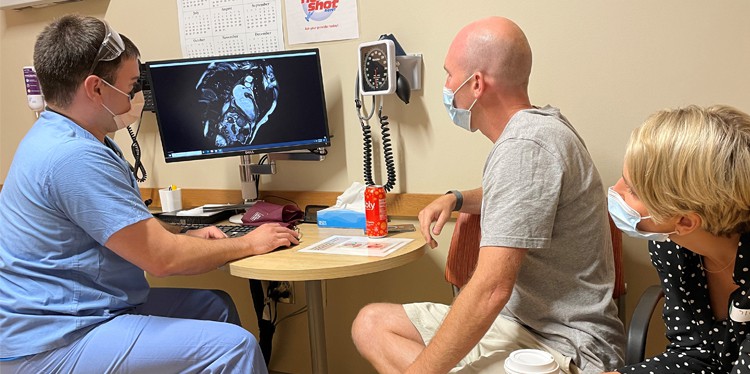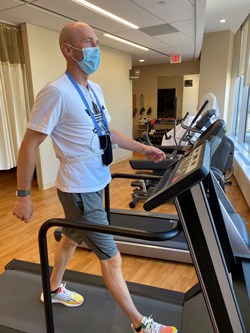Young, healthy – and at risk for a heart attack?

John Grudnowski is a 44-year-old marketing executive who works out 3-4 times a week. He had no apparent risk factors for a heart attack, but on May 22, 2021, that’s exactly what he experienced while living for a short time in Costa Rica.
“I had just completed one of my workouts with a personal trainer and afterward felt like I couldn’t do anything,” he explains. “I could barely even do a push-up, and I began to feel nauseous so I went home. My wife said that everyone was heading to the beach, but I just wasn’t feeling well and wanted to lie down for a while. Never in my wildest dreams did I think I was going to have a heart attack?”
His wife, Ashton, checked on him again and wasn’t comfortable leaving him. He was weak and had vomited several times. John told her that his lungs were “kind of burning” and that his “heart hurt.” That description told her it was time to get immediate medical attention. She rushed him to the nearest clinic.
“Immediately after performing an EKG, clinic staff said John had to get to the hospital in San Jose because he was having a heart attack,” she said. “That’s when the complex coordination efforts began that involved discussions around helicopters, planes, and automobiles – and even locating an available crew to provide transportation. We ultimately landed on a small plane and ground transport to get him to the hospital.”
Ten hours after the initial onset of his heart attack symptoms, the 90 percent blockage of John’s left anterior descending artery was stented and blood flow was returned to his heart, miraculously leaving minimal damage. John and his family returned to Minnesota soon afterward for recovery care.

John on treadmill in Cardiac Rehab at Hennepin Healthcare
At a recent visit to Hennepin Healthcare’s Cardiology Clinic, Michael Konstantinides, PA-C told John:
“I’m not trying to scare you or anything,”
“I’m past that point,” laughed John.
“But your EKG was what we call ‘tombstoning.’”
Michael explained how when you’re having a heart attack, the ECG segment that providers get concerned about starts to rise significantly as the heart attack worsens – often resembling the shape of a tombstone, which parallels the ominous nature of these findings. The segment, called the ST segment, elevates where it would normally be flat. This typically resolves after the artery has been fixed in the catheterization lab.
“I feel so much better after a heart attack.”
Since having a heart attack and his artery repaired, John reports that he can actually notice a difference in his workouts.
“I just feel better, more energized I guess, maybe more oxygenated? I don’t know but it really makes a difference when your artery is working at 100 percent efficiency.”
His recovery includes participating in Hennepin Healthcare’s cardiac rehab program and John’s heart health will be carefully monitored for the rest of his life. He wants to share his story to warn others that a heart attack can strike at any age – even someone as young as 44 with no obvious risk factors.
“I do have some family members who have died of cardiac-related issues, but that was many years ago and I assumed there were other factors involved,” he said. “It wasn’t a major issue on my radar, especially because I was in good shape, exercised, and had no cholesterol problems.”
The other factor that could have played a role was stress. John was working and traveling on a difficult schedule, often sacrificing sleep.
“Sometimes I got maybe 3 to 4 hours of sleep a night.”
Now he realizes the importance of having a healthy life balance, and his wife and kids couldn’t agree more.
“We are so grateful that he is here with us….there were many moments throughout those 10 hours of getting to the hospital where we were not sure what the future would hold in store for our daughters,” said Ashton. “We are so thankful that now we wholly understand the importance of health and taking care of our physical and mental well-being, for us and for what that means for our family.”
Share a life-saving legacy of health history
John and his cardiologists encourage young people to get those annual check-ups and talk to their providers about any concerns they may have about their cardiac health – including a conversation about risk factors and family history of heart attack and cardiac disease, or whether diagnostic tests like coronary artery calcium scores or a stress test would be helpful. In addition, it’s a good idea to know important numbers like blood pressure and cholesterol levels.
“Don’t minimize the importance of that family history,” John said. “Get that routine check-up – not only for yourself but for your family so they can be aware of their health history and risk factors. It’s a priceless, life-giving legacy you can pass on to your children and future generations of your family.”

